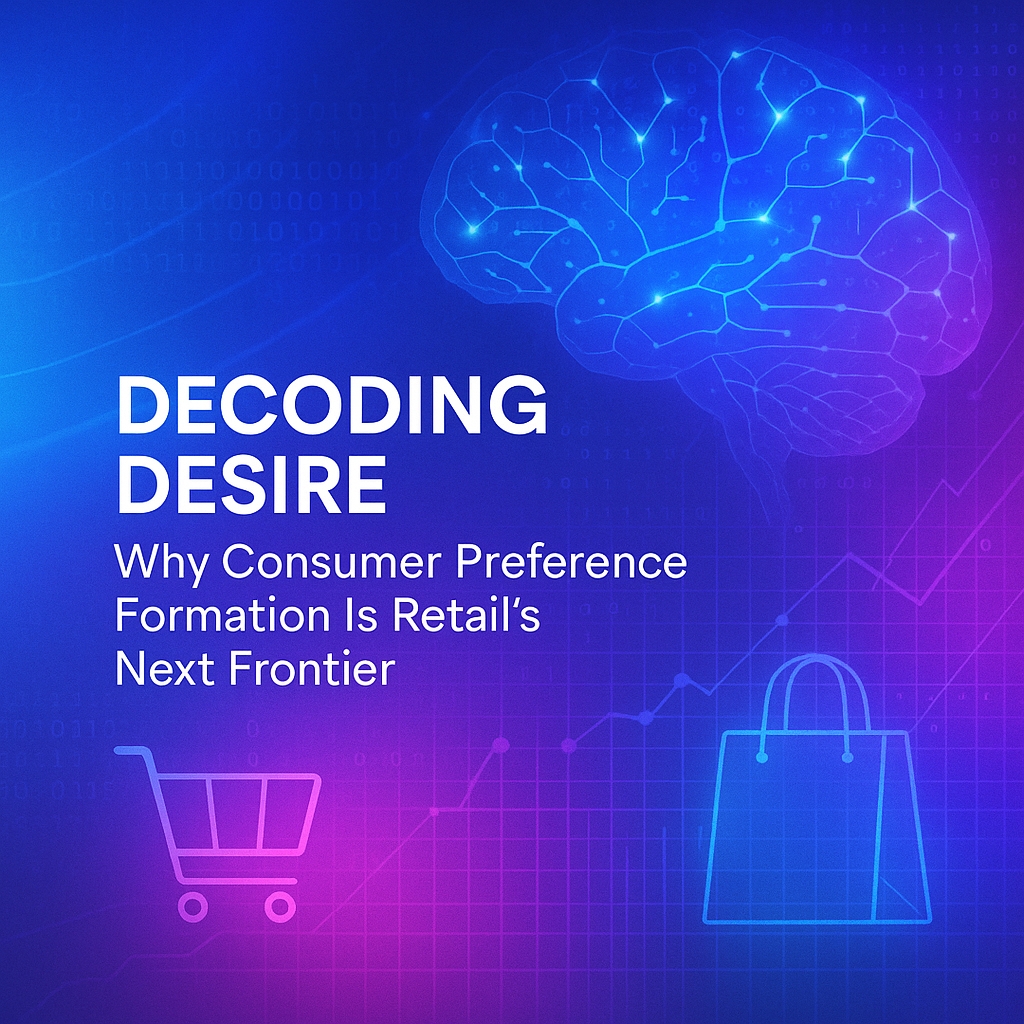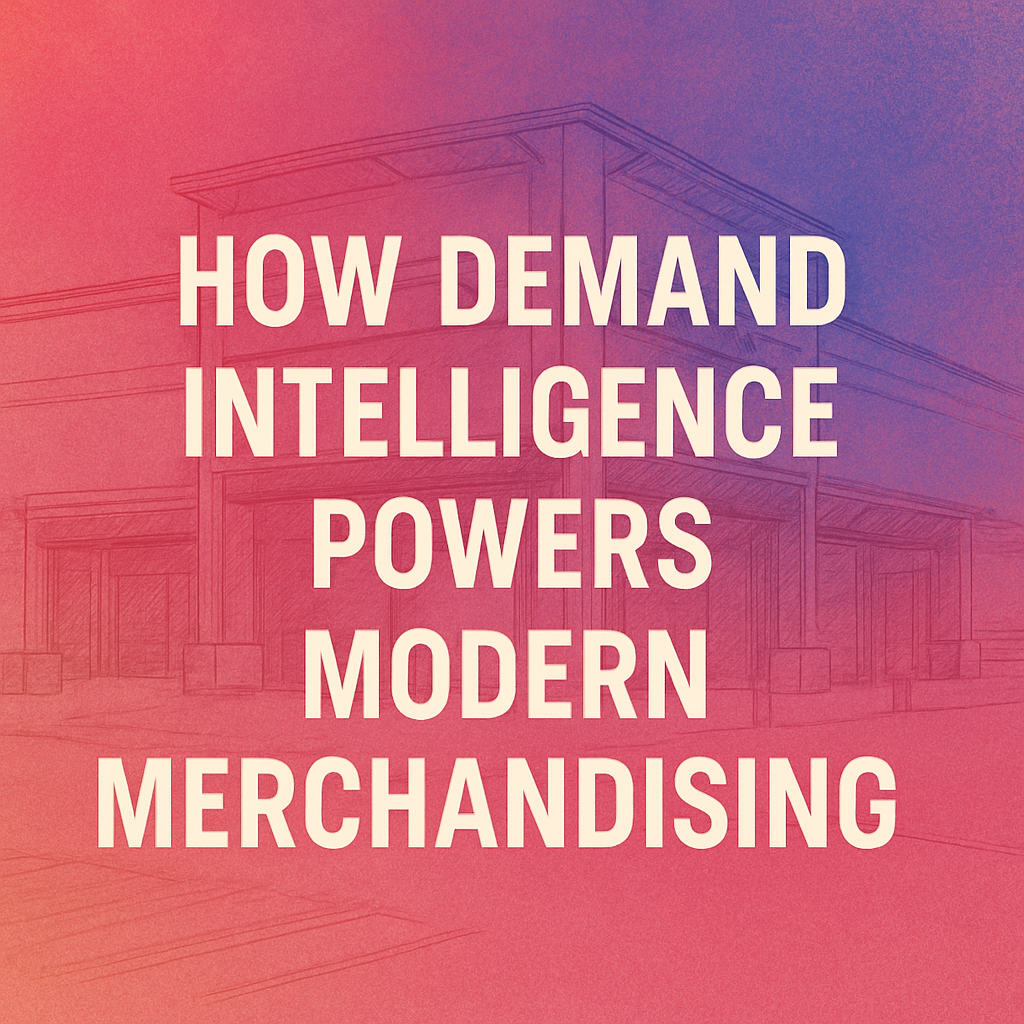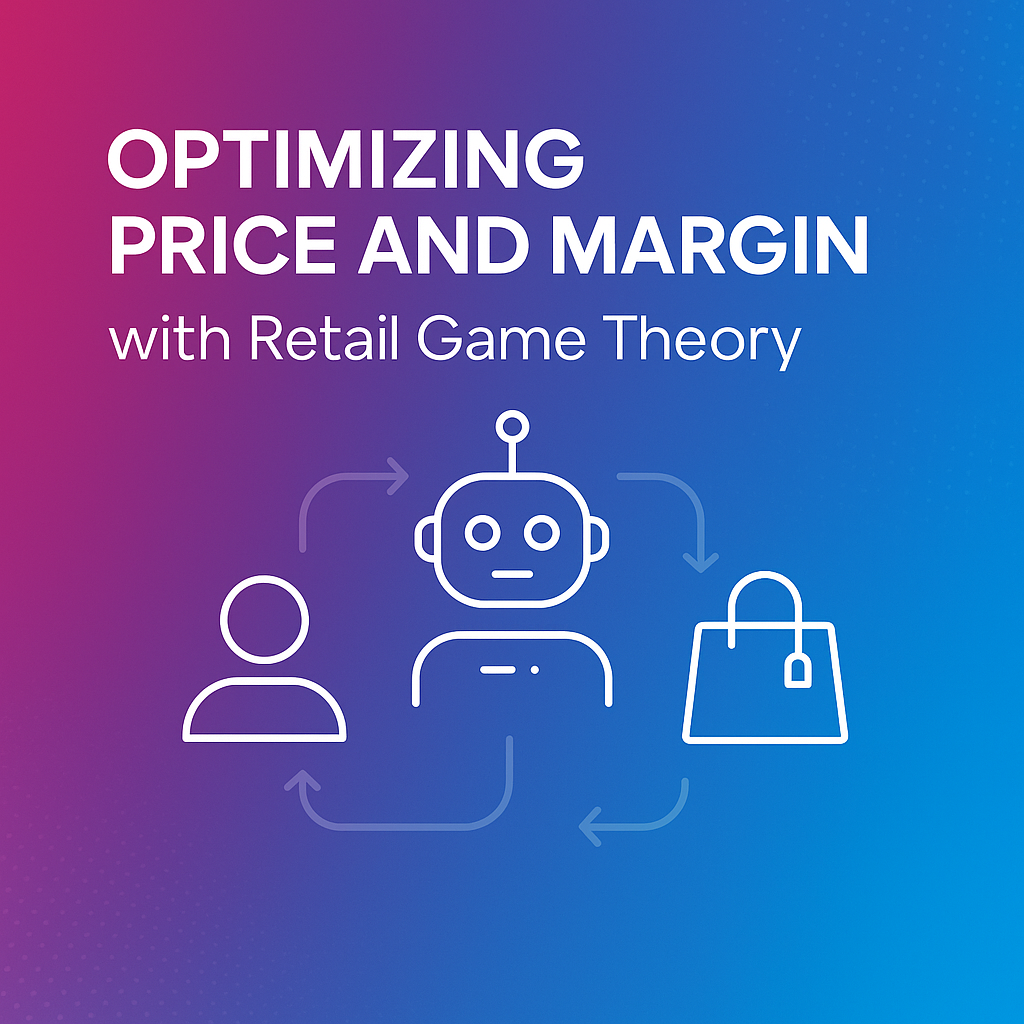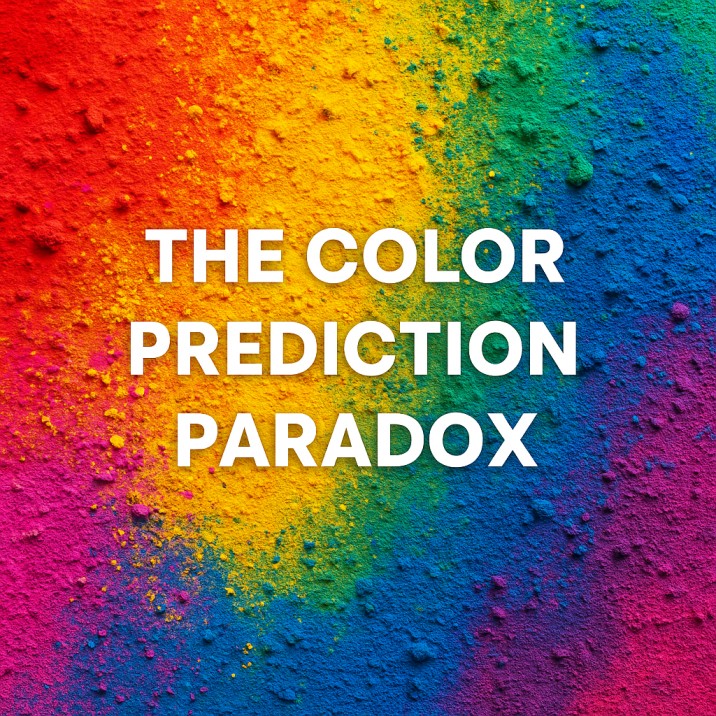Decoding Desire: Why Consumer Preference Formation Is Retail’s Next Frontier

A Glimpse into the Retail Future of 2030
This article presents a futuristic vision of retail that may seem radical today but could become reality within the next decade. By 2030, the concepts explored here—neurological preference mapping, preference formation networks, and biological response monitoring—may transform how products are conceived, designed, and distributed. While elements of these technologies are emerging in research labs today, their full integration into retail systems remains on the horizon. Consider this your roadmap to a future that’s beginning to take shape but isn’t yet fully realized.
The Illusion of Forecasting: Why We’re Looking in the Wrong Place
A man frantically searches for his lost keys under a streetlamp. When asked if he’s sure he dropped them there, he replies, “No, I lost them across the street, but the light is much better here.”
This classic parable, highlighted by entrepreneur Bryan Johnson in his thought-provoking article, perfectly illustrates the current state of trend forecasting and consumer preference analysis in retail. We’re looking where it’s convenient and familiar—historical sales data, social media engagement, and consumer surveys—rather than venturing into the darkness where the real answers might lie.
What challenges does the retail industry currently face?
The retail industry faces unprecedented challenges: staggering waste (with billions worth of unsold inventory discarded annually), rapidly accelerating trend cycles, and increasingly fickle consumer preferences across all categories. Our response? More sophisticated algorithms to predict what consumers might want next, based on what they wanted before.
But what if we’re solving the wrong problem entirely?
The Limits of Current Preference Prediction
Why are traditional predictive analytics insufficient for modern retail?
Traditional analytics fail because they treat consumer preferences as objects to be predicted rather than processes to be understood. Even advanced AI-powered systems focus on pattern recognition within historical data, essentially trying to find correlations between past behaviors and future choices, without addressing the fundamental mechanisms of preference formation.
Today’s most sophisticated systems have grown increasingly complex:
- Social listening tools monitor conversations and engagement across platforms
- Computer vision algorithms analyze millions of product images to detect emerging visual trends
- Purchase pattern analysis examines transaction data to predict future buying behavior
- Sentiment analysis measures emotional responses to products and trends
Yet despite their computational power, these approaches remain fundamentally reactive. They observe the shadows of preferences after they’ve already formed, rather than understanding the neurological, social, and environmental mechanisms that create them in the first place.
As a result, the industry continues to produce massive waste. We’ve gotten better at predicting, but not necessarily at understanding or influencing the underlying dynamics that drive consumer choices—whether for food, technology, home goods, personal care products, or apparel.
The Darkness Where Answers Hide: Neural Preference Formation
What is consumer preference formation?
Consumer preference formation is the complex neurobiological and social process through which humans develop affinities for products and services. Unlike traditional preference prediction, which focuses on outcomes, preference formation examines the fundamental neural, social, and environmental mechanisms that create desires before they manifest as observable behaviors or purchasing decisions.
To find truly transformative solutions, we need to venture into what Johnson calls “the darkness”—the non-obvious, often counterintuitive domains where breakthrough insights emerge.
For retail, this darkness lies in understanding consumer preference formation at its most fundamental level: the neural processes that shape how we develop affinity for products, features, and experiences before these preferences manifest as observable behaviors.
How does the brain form product preferences?
The brain forms product preferences through interconnected neural systems including reward prediction circuits, social mirroring mechanisms, identity reinforcement pathways, and sensory processing networks. These processes occur largely outside conscious awareness and begin long before a purchase decision is made.
Consider this: before a consumer clicks “purchase” or enters a store, their brain has already engaged in complex neural processing. This includes:
- Reward prediction circuits that encode expectations about how a product might make them feel
- Social mirroring mechanisms that help adopt preferences from their community
- Identity reinforcement pathways that evaluate how choices align with self-concept
- Sensory processing systems that detect and categorize product features
These neural processes occur largely outside conscious awareness, yet they fundamentally shape what consumers eventually desire—long before these desires become detectable through traditional analytics.
The Amoeba Solution: Finding Unexpected Answers
In his article, Johnson highlights a fascinating discovery: Japanese researchers demonstrated that an amoeba—a single-celled organism—could efficiently solve the complex Traveling Salesman Problem using an approach entirely different from human or computer methods.
This provides a perfect analog for retail’s current predicament. Just as the amoeba solved the problem through novel biological mechanisms, understanding consumer preferences may require looking beyond conventional analytics to the biological mechanisms of preference formation.
What would a fundamentally different approach to consumer preferences look like?
A fundamentally different approach would map the actual neural, social, and environmental network through which preferences emerge, rather than just predicting future preferences based on past behavior. This would transform how brands design, produce, and distribute products across all categories by addressing preference formation at its source.
Mapping the Preference Formation Network
A preference formation network isn’t just an incremental improvement on existing prediction models—it’s an entirely different approach that maps how preferences actually emerge, evolve, and propagate:

What are the key components of a preference formation network?
A preference formation network consists of three interconnected layers: the biological layer (neural processing), the social contagion layer (how preferences spread), and the environmental context layer (external factors). Together, these create a comprehensive map of how preferences develop and evolve across populations.
This network consists of multiple interconnected layers that function similarly across all retail categories:
The Biological Layer
At the foundation lies the neurological processing that shapes preferences at their most fundamental level. This involves:
- Eye movement patterns that reveal attentional focus on specific product features
- Emotional responses that encode positive or negative associations with products
- Memory formation processes that consolidate product preferences over time
- Neurological reward signals that reinforce certain consumption choices
Research in neuromarketing and consumer neuroscience has already begun scratching the surface of these mechanisms:
- In food retail, neuroimaging studies show how packaging colors trigger specific emotional responses before conscious evaluation of the product
- For electronics, eye-tracking reveals how consumers visually process device features in predictable patterns that influence perceived value
- With home goods, tactile interactions create neurological responses that predict purchase intent more accurately than verbal feedback
The Social Contagion Layer
Preferences rarely form in isolation—they spread through social networks through complex contagion patterns:
- Influence vectors that determine how preferences propagate between individuals
- Adoption thresholds that determine how many exposures are needed before adoption
- Network position effects that privilege certain individuals as preference catalysts
- Counter-preference mechanisms that drive some consumers to reject mainstream trends
Social media has dramatically accelerated and altered these dynamics across all retail categories:
- Technology adoption now follows measurable social network patterns with identifiable thresholds
- Food preferences spread through visual social platforms in predictable contagion waves
- Home decor trends propagate through influencer networks with quantifiable velocity
The Environmental Context Layer
External factors provide the backdrop against which preferences form and evolve:
- Seasonal rhythms that influence color and material preferences
- Economic conditions that shift priorities between quality, status, and value
- Cultural events that create collective attentional shifts
- Geographic factors that create regional variation in preference patterns
From Reactive to Proactive: A New Paradigm for Retail
What technologies will drive preference formation mapping in the future?
Future preference mapping will rely on multi-modal sensing technologies including portable neuroimaging, advanced eye-tracking, emotion recognition systems, social network analysis tools, and environmental context sensors. These will be integrated through AI systems that can correlate biological responses with social patterns and environmental contexts.
Understanding preference formation at this fundamental level would transform retail from reactive prediction to proactive architecture across all categories:
1. Pre-Cognitive Design
Rather than designing products and then testing market response, brands could design specifically for how the brain processes sensory information. This approach would integrate knowledge of:
- Which sensory combinations create the strongest neurological reward responses
- How specific visual patterns affect processing and memory formation
- Which tactile experiences trigger the strongest positive emotional associations
- How product features interact with identity-formation neural circuits
For example:
- Food companies could develop flavors optimized for neurological reward response rather than reported taste preferences
- Electronics brands could design interfaces based on how the brain processes information rather than explicit user feedback
- Home goods manufacturers could create products with tactile properties that activate specific neural pathways
2. Preference Stability Mapping
Different product categories exhibit dramatically different preference stability profiles. By understanding these patterns, production could be optimized with longer runs for stable preferences and smaller, more frequent runs for volatile ones.
How will preference formation networks reduce retail waste?
Preference formation networks will reduce retail waste through pre-emptive production adjustment, preference stability mapping, and neural resonance testing. By understanding preference formation at its source, production can be aligned with true demand patterns before they fully emerge, potentially reducing overstock by 30-50% across retail categories.
This would reduce clearance discounting by tailoring production volumes to match the neurological stability of different preference types, potentially reducing overstock by 30-50% across retail sectors.
3. Neural Resonance Testing
Beyond traditional focus groups that ask consumers what they like, neural resonance testing would measure how products activate relevant brain circuits—often revealing preferences consumers themselves aren’t consciously aware of.
This allows for identifying products with broad neural resonance across diverse consumer segments, reducing the need for excessive SKU proliferation while maintaining sales. For instance:
- Personal care brands could test formulations for neurological response rather than reported preferences
- Furniture designers could measure unconscious comfort responses through neurological monitoring
- Technology companies could develop features that create stronger neural engagement
4. Preference Formation Intervention
Perhaps most revolutionary is the potential to actively guide preference formation toward more sustainable choices. By understanding the neural mechanisms through which preferences form, brands could:
- Design sustainable materials with sensory properties that activate reward circuits more effectively
- Create social contagion strategies that lower adoption thresholds for eco-friendly options
- Develop marketing that synchronizes with natural preference formation patterns
From Homo Erectus to Homo Consumer: An Evolutionary Leap
Johnson’s article draws a compelling parallel between our ancient ancestor Homo erectus—who made the same stone axe for over a million years—and modern humans with our remarkably flexible cognition. This evolutionary journey provides an apt metaphor for retail’s potential transformation.
Current retail analytics represent the Homo erectus approach: incremental improvements on the same basic methodology. The preference formation network represents an evolutionary leap—fundamentally rewiring how we understand consumer choice across all categories.
Just as modern humans would struggle to explain the stock market to Homo erectus, explaining preference architecture to today’s retail analysts might seem equally challenging. The conceptual leap is that significant.
Ethical Considerations in Preference Architecture
What ethical considerations should guide preference architecture?
Ethical preference architecture requires five key principles: transparency about how preference data is collected and used, consumer agency in data sharing and preference development, sustainability as a guiding value in preference intervention, diverse representation in research, and strict guidelines against neurological manipulation for profit.
This powerful new approach raises important ethical questions. If brands can understand and potentially influence the very mechanisms through which preferences form, they must exercise this capability responsibly.
Key ethical guidelines would include:
- Transparency about preference formation research and applications
- Consumer agency in how their neural and behavioral data is used
- Sustainability as priority in preference formation interventions
- Diverse representation in neural response studies
- Avoiding manipulation that exploits neurological vulnerabilities
The Future: A More Connected Ecosystem
How will preference formation change the brand-consumer relationship?
Preference formation technology will transform brand-consumer relationships from transactional to truly symbiotic. Brands will gain deeper understanding of consumer needs at a neurological level, while consumers will experience products that align more authentically with their identity and desires, creating stronger connections and reducing waste simultaneously.
As preference formation networks mature, they’ll create unprecedented connection between consumers and brands across all retail categories:
- Product developers will understand at a deeper level how their creations resonate with human cognition
- Consumers will experience products that align more authentically with their identity and desires
- Brands will produce with greater precision, dramatically reducing waste
- The environment will benefit from significantly reduced resource consumption
This isn’t merely a technical evolution but a relationship transformation—consumers and brands becoming more deeply interconnected through understanding the fundamental processes that shape preferences.
A Work in Progress: Exploring the Darkness Together
This approach to consumer preference formation represents a work in progress—an exploration into the “darkness” where transformative answers may lie. It requires multidisciplinary collaboration between neuroscientists, data scientists, product developers, and sustainability experts.
The path forward involves:
- Developing multi-modal sensing systems that capture the biological, social, and environmental signals that shape preferences
- Creating integrated models that map how these signals interact in preference formation
- Testing hypothesis about preference stability, contagion, and intervention
- Gradually implementing findings in design, production, and distribution processes
As Bryan Johnson notes regarding our evolutionary potential: “Our brains are incredibly capable of evolving and adapting to new and more complicated things.” The retail industry must similarly evolve—not just improving prediction algorithms but fundamentally reimagining how we understand consumer preference.
The future belongs to those willing to venture into the darkness, where the real keys to transformation lie waiting to be discovered.
We at Stylumia are constantly thinking about how we can bring consumers and businesses closer. Check out our latest introduction to the intelligence mix Orbix here.




